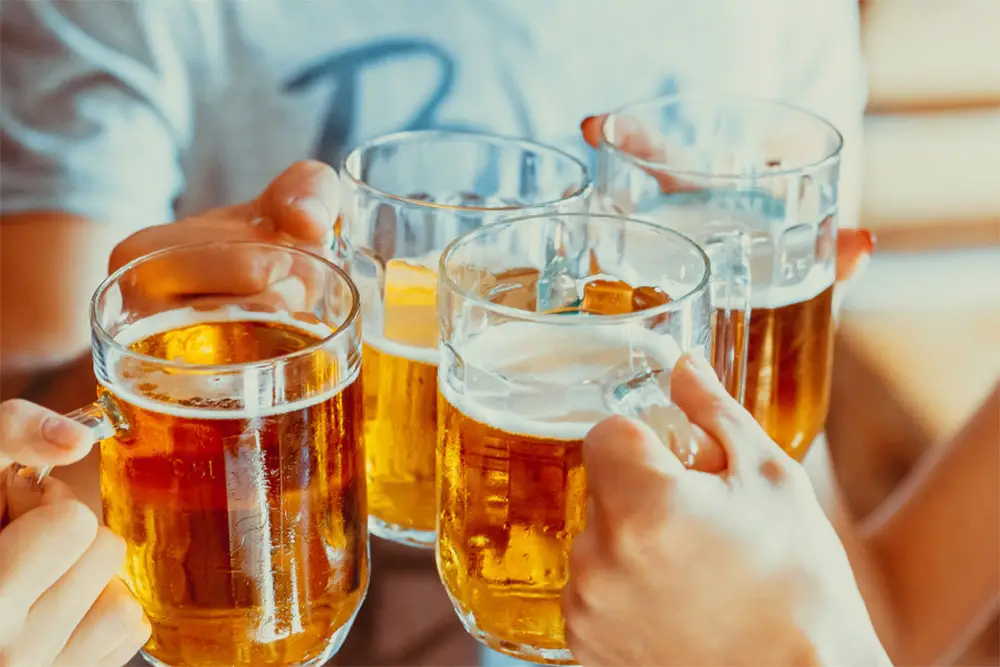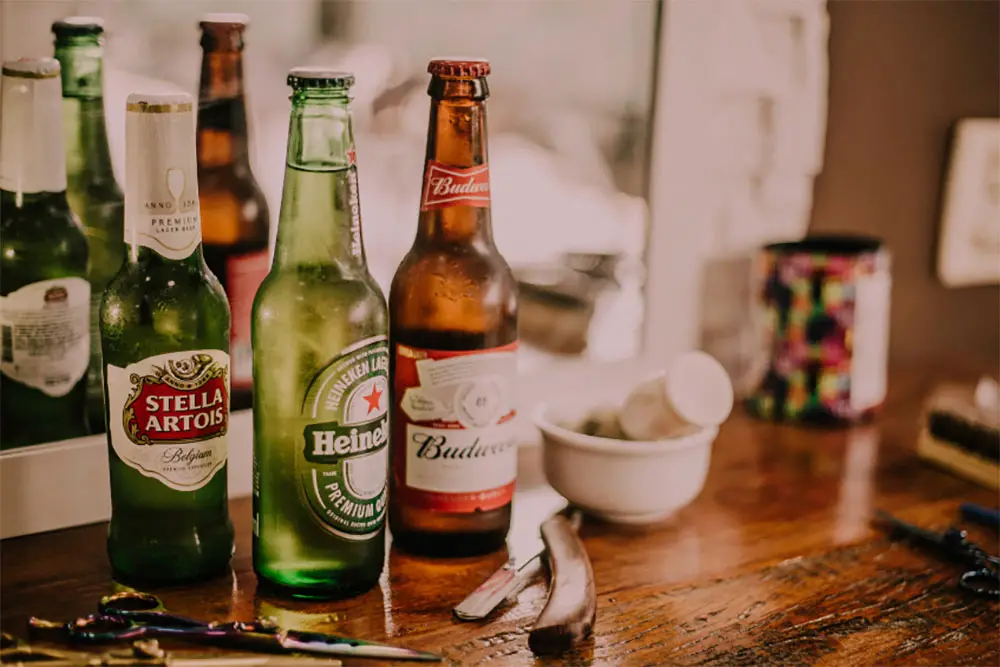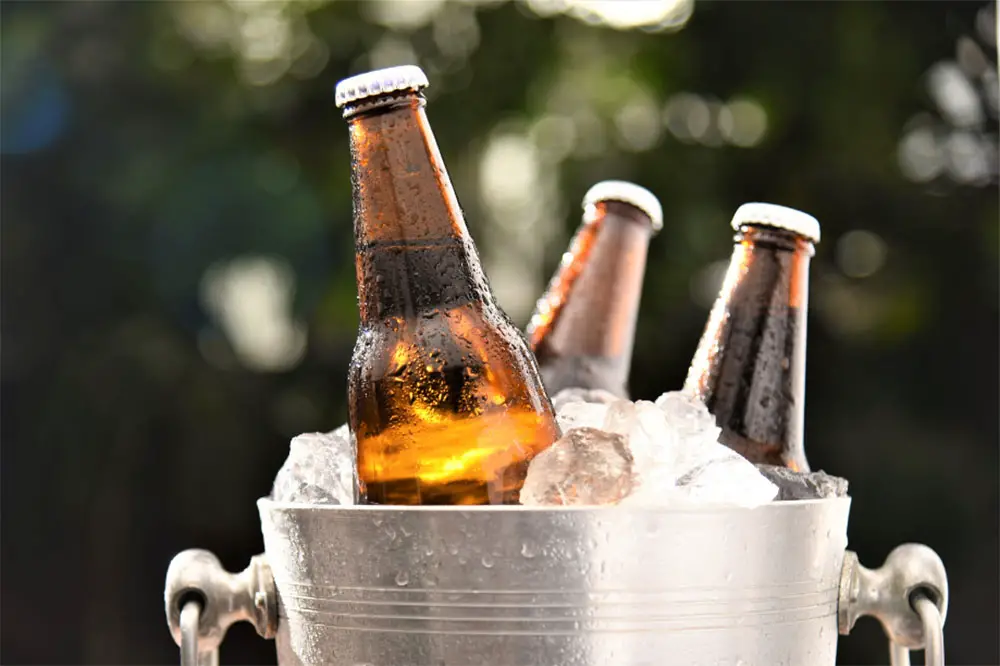You may be surprised to find out that there are many flavors of beer out there. Depending on the ingredients it can be sweet, sour, or bitter, and the storage process (for instance is the beer fresh, canned, and bottled) as well as the age of the beer and the manufacturer can also have an impact on how the beer tastes.
This begs the question of what is beer supposed to taste like, and how do you know what a really good beer tastes like?

BEER DROP: Boxes of beer from Award-winning microbreweries → Join The Club
We’ll try to answer that question below, and delve a little deeper into beer’s spectrum of flavors!
What Is The Flavor Of Beer?
If you’re not familiar with the taste of beer, it’s surprising to discover that it has many different flavor profiles.
Bitter: Most beers have this flavor profile, and that’s because alcohol is itself bitter. Most alcohols include an ingredient called ‘hops’ that come from the plant Humulus lupulus, and this is what gives alcohol a particularly bitter flavor.
Sweet: A sweet flavor profile is also due to a component in almost all alcohols, and that is yeast. Yeast is a sugary substance that is then fermented into alcohol. A lot of beers have a sweet flavor, it all depends on the other ingredients used and how the beer is brewed.
Sour: Yeast can also lend a sour flavor to beer, depending on what strains are used and how they combine with the acidity of the beer once the initial brewing and fermentation processes have been completed.
However, a sour beer may also indicate the drink has gone bad.
Fruity: Beers can be fruity depending on the fermentation process, when brewers add fruit juices or fresh fruit to the mixture as part of the fermentation process.
Is Beer Sweet Or Savory?
Think back to your first sip of beer and probably the first thing you’ll recall is that it tasted really bitter.
But beer fans would probably describe it as sweet or even savory. As we mentioned above, the flavor profiles of beer are determined by the ingredients used to create it.
The beer brewing process involves transforming sugars into alcohol, but the sweet (or bitter) taste of the alcohol can still remain the finished beer.
For those who are used to the bitterness of fermented alcohol, the sweet flavor can actually take over all other flavors. But how sweet a beer is depends on what type of beer is being consumed.
We’ll take you through different types of beers and their different flavors later, so you can order with confidence if you’re thinking of trying a beer for the first time!
What Is Sweet Beer?
The truth is, there isn’t a set definition or criteria for sweet beer other than it tastes, um, sweet. Still, if you do have a sweet tooth and a sweeter beer sounds more appealing to you, there are plenty out there for you to try!

So while there isn’t a set definition, let’s try to define it anyway.
A sweet beer is a beer that generally lacks that stereotypical, bitter beer taste. It is still of course as much of a beer as its bitter, savory cousins as it is brewed like a beer, but it just has a milder taste. Sweet beer is often referred to as a ‘dessert beer’ because of its sweetness.
Just like every other kind of beer, there is good sweet beer and bad sweet beer, but sweet beer does come under more scrutiny because it’s sweet flavor does set it apart from its rivals.
A sweet beer can also fall into different beer subcategories. For example, an ale and a pale lager can both be considered a sweet beer if it doesn’t have a traditional beer flavor, and tastes a little sweeter.
Therefore, it’s hard to determine what makes a good sweet beer. It’s just as hard of a question to answer as what makes a good beer in general. Yes, there are certain components that make a beer great but it does all come to personal preference.
Types of Beer And Their Tastes
As mentioned above, beers aren’t just sorted into different flavor profiles but by different types of beer manufacturing and by the regions where they are produced. The manufacturing process does affect the overall flavor after all.
Below, we’ll explore some popular beer types and discover exactly what they taste like:
American Lager
This is the most popular bottled and canned beer and is often regarded as a ‘light’ lager. Iconic brands like Coors and Budweiser are American lagers, and like most lagers they are softly flavored, not overly bitter or sweet, and have a light color.
Amber American Lager
Even if you’re not a beer fan, you’re sure to have heard of Samuel Adams Boston Lager. Well, that famous beer is an amber American lager. It’s produced with both light and medium hop flavors and has a taste that is surprisingly smooth. Yuengling Lager is also a noticeable amber American lager.
These beers are known for their malty, rich flavors and their scent reminiscent of caramel. These sweet and dark beers pair well with cheese.
American Pale Ale
These ales have rich hop flavors unlike other darker beers, and popular options like the Smuttynose Shoals Pale Ale have a light, brownish color. These ales are also rather light in flavor and pair well with seafood.
German Pilsner
If you’re a fan of malty flavors, then a German Pilsner might be for you. They are particularly malty beers, you can definitely taste the hops in them! A popular pilsner is Sierra Nevada’s Nooner Pilsner. Pilsners are slightly darker than lagers, possessing a pale gold color. They are also richer in flavor.
Vienna Lager
This is a dark lager. Dos Equis Amber lager is a popular variety of this beer and it has a sweet taste.
It tends to have a higher sugar content than other beers and also a dark color. Unlike Pilsners where the hops flavor is obvious, the flavor is mild in Vienna lager making for a sweet and malty beer.
English Brown Ale
A dark ale with a caramel scent, English brown ales are known for their rich maltiless and strong, nutty flavor. Newcastle Brown Ale is a popular example of this beer. They also tend to be a bit heavier than other beers, especially compared to a crisp Vienna lager, which means they pair well with meats and cheeses.
English Bitters
These beers are rich in hops, as well as being bitter and fruity. Sharp’s Brewery’s Doom Bar Butter is a popular option that is sweet and crisp. They are also light in flavor, and compared to other beers relatively low in alcohol content. If you like fruitier flavors, this sweet beer may be for you.
Does Bottled Beer Taste Different To Canned Beer?
Like other drinks, beer does taste different depending on if you’re drinking it from a bottle or can or straight out of the trap. But what is the specific difference between a case of stored beer and totally fresh beer?

Bottled/Can Beer
There actually is not much evidence to suggest that bottled beer tastes better than canned beer. Blind taste tests have even shown that not to be the case, and canning may even be better than bottles when it comes to long-term beer storage.
However, there is a difference between the taste of bottled/canned beer and craft beer that’s stored in a keg.
While bottled beer is prone to oxidation caused by light, it is pasteurized to keep the beer safe.
All of this affects the taste of beer, as it’s less fresh than beer that comes from a newly tapped keg.
Craft Beer From a Keg
Also known as draft beer, craft beer from a keg often tastes fresher and crisper than beer that is bottled or canned.
This is because once a keg is opened, it tends to be drunk quicker than canned or bottled beer. This makes it less prone to oxidation, giving it an overall better taste.
The keg can even add flavor to some beers, particularly if the brewer has added flavored extracts to the keg.
Why Does Beer Taste Better In A Glass?
Most beer fans are in agreement that beer tastes better out of a glass. But why does it taste better in a glass that it does in a can or bottle?
Quite simply, when beer is poured into a glass, it undergoes a process of carbonization. During this process, carbon bubbles are released into the beer.
This carbonization is what creates the famous foam you see in craft beers or any other beer that is poured into the glass. The bubbles are constantly forming and popping, and, as they do, they give off a flavorful aroma that affects the overall taste of the drink.
What you get is a better beer that has a rich taste and smell, and that is why so many beer fans enjoy their beer more from a glass.
Beer from a can, bottle, or any other container doesn’t undergo this carbonization process, which means the beer tastes flatter than beer enjoyed in a glass.
But a better flavor isn’t the only benefit to drinking beer from a glass.
Drinking beer from a glass allows you to see the color of the beer and what type of foam is produced (thick or thin). This gives you a better idea of what the beer will taste like, and how malty or creamy it will be.
How Ingredients Affect The Taste Of Beer
If you’re making homemade beer and had some disappointing results, it may be worth considering how each beer gets its flavor.
The taste of beer is changed in the brewing process through the use and mixture of three basic ingredients, which are: yeast, hops, and barley. But what impact do these flavors have on the taste of beer? Let’s find out!
Yeast
The substance that facilities the fermentation process, yeast turns sugars into alcohol, and how much yeast you include depends on the type of beer you make.
It’s a well-known fact that raising or lowering the amount of yeast can make the distinction between creating an ale or a lager.
As we’ve already mentioned, yeast has sugars and therefore it will add a sugary flavor to beer.
However, you can make alcohol without adding yeast but not entirely. Yeast is a micro fungus that lives in the air. In the right conditions, your alcohol will even ferment without supplementing it with additional yeast. It instead uses naturally occurring yeast and bacteria in the air to ferment.
Yeast is used for the vast majority of alcohol production, and beer, in particular, is especially dependent on yeast. You can’t really make a successful beer without it. Without any yeast involved, there isn’t really a way for the sugar to turn into alcohol.
While some alcohols will claim to be yeast-free, they most likely mean that the alcohol is free of manually added powdered or other types of processed yeast.
Barley
A common substance in beer barley (especially malted barley), is used to add sugar to beer during the fermentation process. Barley is what yeast draws on to produce carbon dioxide and alcohol.
Barley can affect the sugar levels of beer and the taste by imparting added sweetness. Barley is also grainy, so can add a grainy texture or flavors to beers depending on how much is used.
Hops
Derived from female flowers, hops are usually used to add a bitter or tangy flavor to beer.
Generally, the more hops a beer contains, the more bitter it will become. Sometimes hops are added to provide a more balanced and sophisticated flavor to beer.
Does Beer Taste Good?
Beer generally isn’t considered to taste very good, especially to those who don’t drink it regularly. When trying beer for the first time, people tend to find it too bitter and not very palatable. But beer is still incredibly popular.
In 2018, nearly 200 million liters of beer were consumed around the world. Therefore, beer is still a pretty enjoyable drink despite its reputation of being an overall bitter drink. Like any alcoholic drink, it is an acquired taste.
The most unpleasant thing about beer is the alcohol, but the more you drink beer, the more acquired you become to the taste. Soon, you’ll be able to detect and appreciate other flavors, especially as you explore the wider spectrum of beer.
What Does Bad Beer Taste Like?
So now that we have a pretty good idea of what a beer tastes like when it’s good, what does it taste like when it’s bad?
Stale: When beer has been exposed to a lot of oxidation, it goes stale. This means it’s no longer crisp or fresh. Not only is it generally unappealing to drink, but rather flat too.
Popcorn: Yes, old beer can taste like popcorn! As far as sour beers go, this isn’t the worst flavor you could experience, but it should still be avoided as it’s not fresh and could give you a stomachache.
Cabbage or sewage: You’ll know a beer has gone bad when it tastes like either of these too. You can probably tell before you drink it, as it will have a strong aroma like that of a skunk. This is why this kind of beer is commonly called ‘skunked’ beer.
Conclusion
Beer comes in so many flavors that it’s hard to determine what it should taste like, but it should either taste rich, creamy, malty, sweet, sour or bitter, with combinations of either of these flavor profiles. It should not taste like popcorn or cabbage! If you’re new to beer and want to give it a try, keep those flavor profiles in mind.
Hopefully, you now know all the different flavor profiles of beer, as well as be able to tell whether a beer has gone bad.
